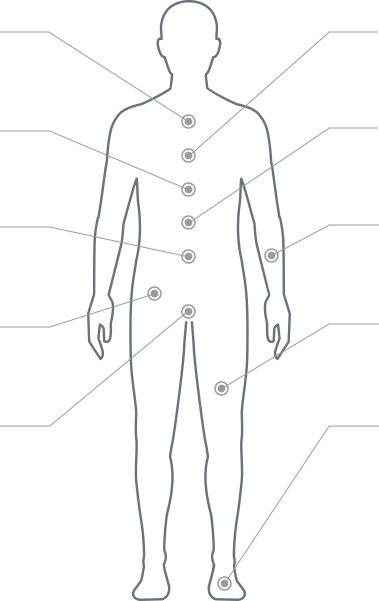The Different Chronic Pain Types

We all experience pain from time to time. It is an important warning signal that tells you something isn’t right in your body. While acute pain usually comes on suddenly and goes away when an injury heals, chronic pain is persistent and debilitating.
If you live with chronic pain, you’re not alone. In the United States, millions of people live with chronic pain, meaning it has lasted for longer than three months. Because treating pain can be tricky, finding effective treatment options can be a long and frustrating journey. But there is hope. There are many treatment options available.
Newer options, like spinal cord stimulators, are helping people experience significant pain relief.
Chronic pain types
So, what do you need to know about chronic pain? What are the different types of pain and why does the type of pain matter?
There are two types of chronic pain. You may experience just one type or a mix of both types. Understanding the cause of the pain is the best way to determine which treatment options will provide the most relief.
Mechanical pain
When bones, ligaments, tendons, or muscles are damaged, the injury can cause pain. Doctors call this type of pain mechanical pain. If you have chronic pain after an injury, it is likely mechanical pain.
Nerve pain
Neuropathic pain is often called nerve pain. Damaged nerves can overproduce pain signals, and this type of pain occurs when these false pain signals are sent to your brain. When the signal is strong, so is the pain. Because there is often no obvious pain source, nerve pain can be challenging – but not impossible – to treat.
What are the pros and cons of common treatment options?
When treating chronic pain, your doctor may prescribe medications, surgery, or injections to help you find relief from chronic pain. Every person and situation is different. So it makes sense that responses to these treatment options vary. They may leave you managing unwanted side effects. Here are some of the pros and cons of traditional treatment options:
Prescription medications
Pros: Medication is often beneficial for acute pain.
Cons: The most significant drawbacks to prescription medication are the potential side effects, including constipation, drowsiness, and potential addiction.
Spine surgery
Pros: If your pain is caused by damage to the bones, ligaments, tendons, or muscles, spine surgery can be an effective treatment option.
Cons: While spine surgery is appropriate for correcting mechanical issues, there is no guarantee that it will reduce your pain. And spine surgery is often ineffective for resolving nerve pain.
Epidural steroid injections
Pros: An epidural steroid injection delivers steroids directly into your spine. You may find injections effective for short-term pain relief.
Cons: Injections typically don’t offer long-term pain relief. If you are receiving epidurals, you will make regular visits to your healthcare provider for treatment.
Get long-term relief from chronic pain
If you live with chronic pain, you may be looking for a long-term option for pain relief. Spinal cord stimulator (SCS) systems have been used in the U.S. for more than 30 years for chronic pain treatment. SCS systems are helping people experience less pain and get back to the things they love.
So, how does it work?
With a spinal cord stimulator, the transmission of pain signals to the brain is interrupted by delivering mild electrical pulses to the nerves. When this happens, many people experience less pain.
HFX™ has been proven to deliver significantly better and longer-lasting pain relief from chronic back and leg pain than other SCS systems. Also, HFX is the most advanced SCS treatment offering the widest range of frequencies and waveforms available to individualize your relief. Learn more about what to expect with HFX.
You don’t have to live with chronic pain. There is hope. With the right treatment plan, you can reduce your pain and regain your independence.
Is HFX right for me?
Curious if HFX could be right for you? The first step is to take a short assessment today. At the end, you can request a call from an HFX Coach who will answer any questions you have and help you find an HFX doctor in your area.
Summary
- There are two types of chronic pain: mechanical pain and nerve pain
- Nerve pain is more challenging to treat, but options are available- each option has pros and cons
- For many people who have had not found sufficient relief from prescription medications and surgery, HFX can be an effective treatment without side effects
Sources
Popular Posts
Take our short assessment to find out if HFX is right for you.
Start NowHFX is covered by all major commercial insurance plans, Medicare, Medicaid, and Tricare.
DOWNLOAD INFORMATION BROCHURERelevant Reads
What to Expect at Your Nevro HFX Consultation
You’ve decided to explore Nevro HFX as a treatment option for your chronic pain. Congratulations! That’s the first step in finding a long-term pain relief solution that doesn’t require drugs or major invasive surgery. A…
How to Choose the Right Pain Management Doctor
If you’ve been living with chronic pain for a long time, you’ve probably tried a wide range of treatment options recommended by your primary care provider. Maybe you’ve tried over-the-counter and prescription medications, physical therapy,…
Why Do I Need a Psychological Evaluation for a Spinal Cord Stimulator?
A spinal cord stimulator is a highly effective treatment option for managing chronic pain. It’s a solution for many people who have tried other ways to manage their pain but haven’t found success with medications,…
How long have you been suffering from pain?
Where is your pain located?
(Select all areas where you experience pain)

On average, rate your pain level over the past 30 days:
No Pain
0 1 2 3 4 5 6 7 8 9 10Worst Pain Imaginable
No Pain
Worst Pain Imaginable
Which treatments have you already tried?
(Select all options you've tried)
What statement describes you best?
Please select your primary type of health insurance:
HFX is covered by all major insurance plans, including Medicare and Tricare.
Commercial insurance is typically offered through your employer or health care exchange. Examples of commercial insurance providers include Blue Cross Blue Shield, Aetna, Cigna, Kaiser, United, and Humana. Close
Thank you for sharing your experience.
At this time, it looks like you might not be an appropriate candidate for HFX. The next best step is to talk with the physician who is treating your pain about your treatment options.
To learn more about who this treatment option is right for, visit our learn center:
Learn MoreOne of the qualifications for HFX is that you need to experience pain for longer than 6 months.
You may not be ready for HFX now, however if your pain lasts longer than 6 months, please come back to see if you qualify.
Learn MoreOne of the qualifications for HFX is that you need to experience moderate to severe pain.
You may not be ready for HFX now, however if your pain severity increases, please come back to see if you qualify.
Learn MoreGood news!
Based on your responses, HFX could be an option for you.
Fill in your information below to get your doctor discussion guide and additional educational information about HFX.
Fill in your information below to connect with your HFX Coach and receive your doctor discussion guide. Your HFX Coach is a real person assigned to you who will answer your questions and help you find an HFX doctor.
Agree to terms
By clicking ‘I agree & submit’, you agree to receive automated SMS texts from Nevro at the mobile number provided and agree to Nevro’s Text Message Terms of Service & Privacy Notice. Message and data rates may apply. Message frequency varies. You can opt-out at any time by texting STOP to 35788. You can also text HELP to 35788 for HELP. You also agree to email and phone communications from Nevro and opportunities to participate in Nevro led research panels and quantitative surveys. You understand that you can choose to participate or decline to participate in any marketing panel. You understand that you can opt-out of further advertising and/or marketing research communications from Nevro by clicking unsubscribe in the email or providing a detailed request to [email protected].
All information will be used in accordance with Nevro’s Privacy Notice.
Looks like you have recently taken the assessment.
Would you like to update your responses?
Your responses are being submitted. Please wait – we’re sending you to a page with more information about HFX.
Please don't click the back button or close your browser. This may take a few seconds.
Your responses have been saved.
Thank you for your time.
Your results and discussion guide will be on their way shortly.
Please find a copy at the email address provided.
Thank you for your time.
We did not update your responses. Your results and discussion guide will be based on your previous responses. Please find a copy at the email address provided.
YOU ARE ABOUT TO EXIT FOR A WEBSITE INTENDED FOR THE RESIDENTS OF ANOTHER COUNTRY OR REGION.
Please be aware that the website you have requested is intended for the residents of a particular country or region, as noted on that site. As a result, the site may contain information on medical devices and other products or uses of those products that are not approved in other countries or regions.
Do you wish to continue?
YOU ARE ABOUT TO ACCESS A WEBSITE INTENDED FOR THE RESIDENTS OF A PARTICULAR COUNTRY OR REGION.
Please be aware that the website you have requested is intended for the residents of a particular country or region, as noted on that site. As a result, the site may contain information on medical devices and other products or uses of those products that are not approved in your country or region.